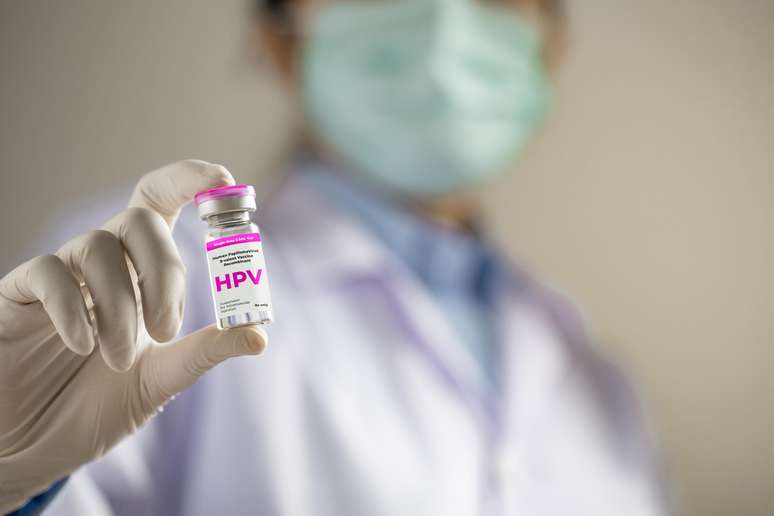The Human Papillomavirus is an STI, Sexually Transmitted Infection, which can affect both men and women; know how to prevent
html[data-range=”xlarge”] figure image img.img-0b59668716074585f83b0a8763e0b5bdvg10d2bh { width: 774px; height: 516px; }HTML[data-range=”large”] figure image img.img-0b59668716074585f83b0a8763e0b5bdvg10d2bh { width: 548px; height: 365px; }HTML[data-range=”small”] figure image img.img-0b59668716074585f83b0a8763e0b5bdvg10d2bh, html[data-range=”medium”] figure figure img.img-0b59668716074585f83b0a8763e0b5bdvg10d2bh { width: 564px; height: 376px; }
Did you know that it can take up to 20 years for HPV symptoms to show up in the body? Data from the Ministry of Health (SM) also inform that in some cases HPV can remain latent for months or years, without showing signs (visible to the naked eye) or presenting subclinical manifestations (not visible to the naked eye).
There are over 100 different types of HPV and they are classified into low-risk and high-risk types according to their ability to cause cancer. Vaccinations and regular Pap smears (for women) can help prevent or detect HPV-related diseases early.
What is HPV and what can it cause?
HPV (Human Papillomavirus) is a virus that infects the skin or mucous membranes (oral, genital or anal), causing anogenital warts (genital and anal region) and cancer, depending on the type of virus. “HPV infection is a sexually transmitted infection (STI)”, specifies the Ministry of Health.
What are the symptoms of HPV in the body?
According to the Ministry of Health, HPV infection has no symptoms in most people. The decrease in the body’s resistance can trigger the multiplication of HPV and, consequently, cause the appearance of lesions. “Most infections in women (especially in adolescent girls) resolve spontaneously, by the body itself, in an approximate period of up to 24 months,” she guarantees.
The first manifestations of HPV infection appear in about two to eight months, but it can take up to 20 years for any signs of infection to appear. Manifestations are usually more common in pregnant women and people with low immunity.
Again depending on the organ, the diagnosis of HPV is made through clinical and laboratory tests, depending on the type of lesion, whether clinical or subclinical.
clinical lesions
Warts in the genital area and anus, usually caused by non-cancerous types of HPV.
subclinical lesions
They are not visible to the naked eye and can be caused by HPV types with low and high risk of developing cancer.
Streaming
Transmission occurs mainly sexually, but there are other transmission possibilities: vertical (mother/foetus), through saliva, self-infection and infection by piercing or cutting with HPV-contaminated objects.
Treatment
Treatment varies according to the patient and can be clinical (with drugs) or surgical. It consists in destroying the lesions. Regardless of the execution of the treatment, the lesions may disappear, remain unchanged or increase in number and/or volume. The information is also from the Ministry of Health. The folder further explains:
- It must be individualized, considering the characteristics (extent, quantity and location) of the lesions, the availability of resources and adverse effects;
- They are chemical, surgical and immunity enhancers;
- They can be home (self-applied: imiquimod, podophyllotoxin) or outpatient (applied in the health sector: trichloroacetic acid – ATA, podophyllin, electrocautery, surgical excision and cryotherapy), according to professional indications on a case-by-case basis;
- Podophylline and imiquimod should not be used during pregnancy.
Prevention
Vaccination, preventive examination and use of condoms are the main ways to avoid infection. According to MS, when these changes that precede cancer are identified and treated, 100 percent of cases can be prevented, which is why it’s very important for people with a vagina to have regular Pap smears.
Vaccine
HPV vaccination is the most effective way to prevent infection. The Ministry reiterates that the vaccine is distributed free of charge by the SUS and is indicated for:
- Girls and boys aged 9 to 14, with a 2-dose regimen. Adolescents receiving their first dose of this vaccine at these ages can take their second dose even after the recommended six-month interval so they don’t miss out on completing their schedule;
- Women and men infected with HIV, solid organ transplant recipients, bone marrow transplant recipients, or cancer patients aged 9 to 45 years, on a three-dose schedule (0, 2, 6 months), regardless of age;
- The vaccine does not prevent infections with all types of HPV, but it targets the most common types: 6, 11, 16 and 18.
Does HPV have a cure?
There are cases where the virus is cleared without the person knowing they have been infected, but there is no specific medicine that kills or eliminates the virus. Healing occurs spontaneously in about 90% of cases, within 2 years, when the person’s immune system is strengthened.
Source: Terra
Ben Stock is a lifestyle journalist and author at Gossipify. He writes about topics such as health, wellness, travel, food and home decor. He provides practical advice and inspiration to improve well-being, keeps readers up to date with latest lifestyle news and trends, known for his engaging writing style, in-depth analysis and unique perspectives.








